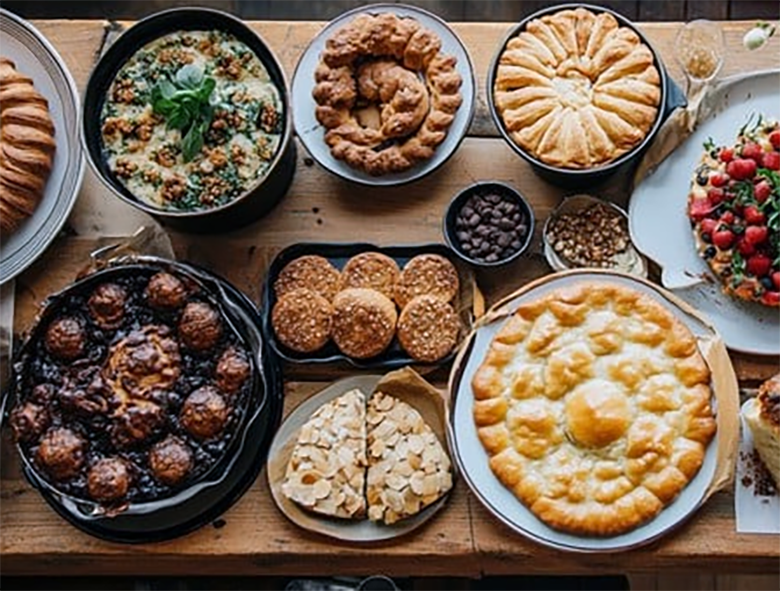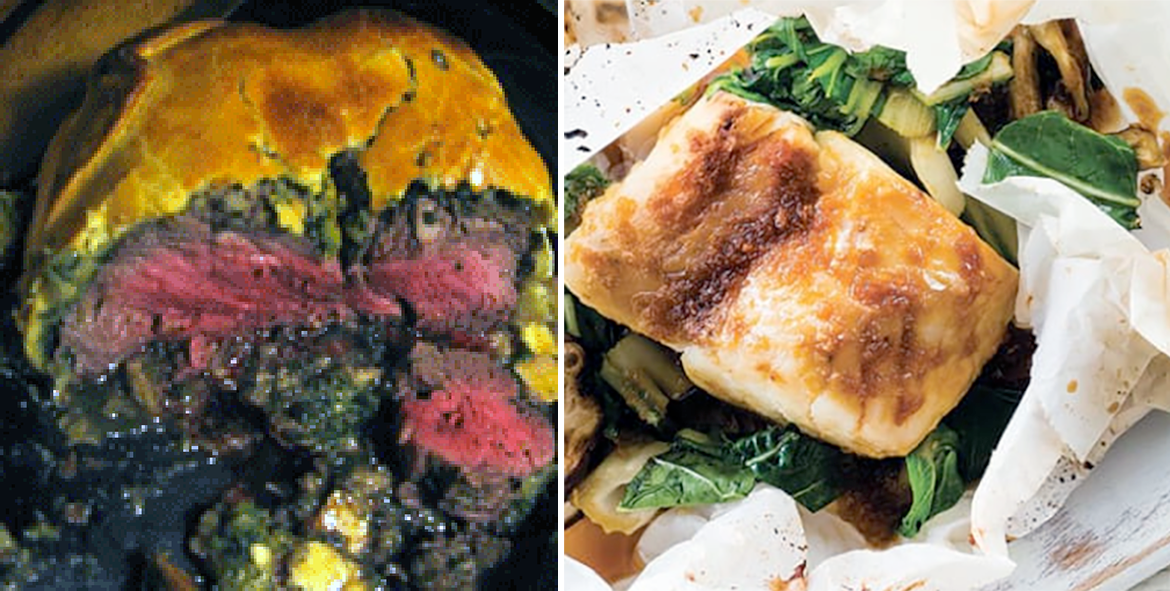FabulousFusionFood's Baking Recipes 3rd Page
 A range of baked goods.
A range of baked goods.
Welcome to FabulousFusionFood's Baking Recipes Page — This is a continuation of an entire series of pages that will, I hope, allow my visitors to better navigate this site. As well as displaying recipes by name, country and region of origin I am now planning a whole series of pages where recipes can be located by meal type and main ingredient. This page gives a listing of all the baking recipes added to this site. Baking is defined as a technique for the prolonged cooking of food using dry heat by the action of conduction. Baking is normally done in an oven, but goods may also be baked in hot ashes or on hot stones. Baking differs from Roasting Recipes in that a lower temperature is typically used and the items are cooked for a longer period of time. Baking is a much older process than most people think and foods were probably originally baked in embers or with hot stones (which is how bread may have started). Only later did specialist ovens develop. Though most baked goods tend to be bread or cake-based some other dishes such as pasta dishes and vegetable dishes may also be baked. Stews are often also technically baked in an oven, but are not classed as 'baked goods' in that they are more liquid than solid at the end of the cooking process.
Baking is a method of preparing food that uses dry heat, typically in an oven, but can also be done in hot ashes, or on hot stones. The most common baked item is bread, but many other types of foods can be baked. Heat is gradually transferred "from the surface of cakes, biscuits and cookies, and pieces of bread to their centre, typically conducted at elevated temperatures surpassing 150°C. Dry heat cooking imparts a distinctive richness to foods through the processes of caramelization and surface browning. As heat travels through, it transforms batters and doughs into baked goods and more with a firm dry crust and a softer centre. Baking can be combined with grilling to produce a hybrid barbecue variant by using both methods simultaneously, or one after the other. Baking is related to barbecuing because the concept of the masonry oven is similar to that of a smoke pit.
In addition to bread, baking is used to prepare cakes, pastries, pies, tarts, quiches, biscuits and cookies, scones, crackers, pretzels, and more. These popular items are known collectively as 'baked goods', and are often sold at a bakery, which is a store that carries only baked goods, or at markets, grocery stores, farmers markets or through other venues.
 Beef en croûte (left) and fish en papillote (right).
Beef en croûte (left) and fish en papillote (right).
The alphabetical list of all the baking recipes on this site follows, (limited to 100 recipes per page). There are 2205 recipes in total:
Page 3 of 23
| Basic Focaccia Origin: Italy | Biga Pugliese Origin: Italy | Blackberry-glazed Lemon and Blackberry Loaf Cake Origin: Britain |
| Basic Génoise Sponge Origin: France | Bilberry 'Mucky Mouth' Tart Origin: Britain | Blackcurrant Cheesecake Origin: Britain |
| Basic Pastry Origin: England | Bilberry Cheese Tart Origin: Britain | Blintzes with Cream Cheese and Cinnamon Origin: Jewish |
| Basic Vanilla and Chocolate Cupcakes Origin: Britain | Bird Cherry Flour Origin: Britain | Blitz Kuchen (Lightning Cake) Origin: Germany |
| Basic White Bread Origin: Europe | Bird Cherry Flour Bread Origin: France | Blood orange upside-down cake Origin: Britain |
| Basic Yeast Dough Origin: British | Birds' Nest Cupcakes Origin: American | Blueberry Cheese Tart Origin: Britain |
| Basler Leckerli (Basel Biscuits) Origin: Switzerland | Birthday Biscuits Origin: British | Blueberry Cupcakes Origin: Britain |
| Basyniai (Walnut and Fig Cakes) Origin: Roman | Biscotti Mandorle e Pistacchio (Pistachio and Almond Biscuits) Origin: Italy | Boîte au Chocolat aux Fruit Origin: France |
| Bath Buns Origin: Britain | Biscuit Origin: Mayotte | Boboli Pizza Crust Origin: Italy |
| Bayerischer Käsekuchen (Classic Bavarian Cheesecake) Origin: Germany | Biscuit-topped Lamb Casserole Origin: America | Bobotie (Curried Meat Loaf) Origin: South Africa |
| Beech Nut Muffins Origin: Britain | Biscuits Molleux aux Carrotes et Cumin (Soft Carrot and Cumin Biscuits) Origin: Mali | Bocaditos de Frambuesa y Queso (Raspberry and Cheese Bites) Origin: Spain |
| Beef and Pistachio Terrine Origin: Britain | Bisgedi Brynog (Brynog Biscuits) Origin: Welsh | Bojo (Suriname Cassava and Coconut Cake) Origin: Suriname |
| Beef Wellington Origin: Britain | Bisgedi Ceirch (Oat Biscuits) Origin: Welsh | Boletinos Artos (Mushroom Bread) Origin: Roman |
| Beer Cakes Origin: Ancient | Bisgedi Ceirch Euraidd (Golden Oat Biscuits) Origin: Welsh | Bolo à Moda da Guiné Bissau (Cake in the Style of Guinea-Bissau) Origin: Guinea-Bissau |
| Beetroot and Cranberry Cupcakes Origin: Britain | Bisgedi Cennin Pedr (Daffodil Biscuits) Origin: Welsh | Bolo de Ananás (Angolan Pineapple Cake) Origin: Angola |
| Beetroot and Guinness Cupcakes Origin: Ireland | Bisgedi Gele (Gele Biscuits) Origin: Welsh | Bolo de Chocolate com Frutas (Chocolate Cake with Fruit) Origin: Brazil |
| Beetroot Cake with Orange Icing Origin: Britain | Bisgedi Nadolig (Christmas Biscuits) Origin: Welsh | Bolo de Laranja (Orange Cake) Origin: Brazil |
| Beigli Origin: Hungary | Bisgedi Pasg (Easter Biscuits) Origin: Welsh | Bolo Polana (Cashew Nut Cake) Origin: Aruba |
| Belgian Slice Origin: Britain | Bisket Bread Origin: Britain | Bolo Preto Portuguesa (Portuguese Black Cake) Origin: Portugal |
| Belizean Bread Pudding Origin: Belize | Bisquick Copycat Mix Origin: American | Bonnag Arran Oarn (Barley Meal Bonnag) Origin: Manx |
| Belizean Sweet Potato Pone Origin: Belize | Bizcocho de almendras (Almond Cake) Origin: Spain | Bori (Bengali Baked Dumplings) Origin: India |
| Benne-seed Wafers Origin: West Africa | Bizcocho de chufa (Tigernut Cake) Origin: Spain | Boston Cream Pie Cheesecake Origin: America |
| Bergamot and Cheese Tuiles Origin: Britain | Bizcocho de Uvas con Sopa de Chocolate (Grape Cake with Chocolate Sauce) Origin: Spain | Boudin de Pescado (Fish Pudding) Origin: Spain |
| Bermuda Salmon Origin: Bermuda | Bizcocho de yogur de limón (Lemon and Yoghurt Cake) Origin: Spain | Bourbon Pumpkin Cheesecake Origin: America |
| Bermudan Hot Cross Buns Origin: Bermuda | Black Bun Origin: Scotland | Boxemännercher (Gingerbread Men) Origin: Luxembourg |
| Berreen Giar Vanninagh (Manx Short Cake) Origin: Manx | Black Eyed Pea Flour Bread Origin: Liberia | Braided Easter Bread Origin: Europe |
| Berreenyn Jastee-hollan (Soda Cakes) Origin: Manx | Black Forest Cheesecake Delight Origin: American | Bramble Pudding Origin: Scotland |
| Berreenyn Keyl (Manx Slim Cakes) Origin: Manx | Black Forest Passover Brownies Origin: Jewish | Brambrack Origin: Ireland |
| Berry Cherry Crumble Origin: British | Black Magic Cake Origin: American | Bran Muffins Origin: New Zealand |
| Bethmaennchen (German Marzipan Christmas Biscuits) Origin: Germany | Blackberry and Almond Cake Origin: Britain | Braune Kuchen (Brown Biscuits) Origin: Germany |
| Bhutanese Red Rice Origin: Bhutan | Blackberry Batter Origin: Britain | Brazo de Reina (Dulce de Leche Swiss Roll) Origin: Chile |
| Bhutanese Red Rice Origin: Bhutan | Blackberry Bavarois Origin: Britain | Brazo Gitano (Ecuadorian Swiss Roll) Origin: Ecuador |
| Bienenstich (Bee Sting) Origin: Germany | Blackberry Leather Origin: Britain | |
| Biezpienmaize (Latvian Smoked Sprat Salad) Origin: Latvia | Blackberry Muffins Origin: Britain |
Page 3 of 23